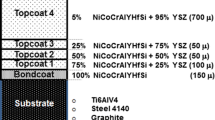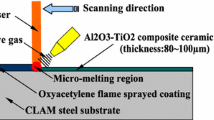Abstract
For the development of metallic and ceramic high temperature materials used, for example, in heat exchanger components, in turbine blades for stationary gas turbines, in ceramic industrial products and fusion reactor components, modern physico-chemical characterization methods are required. The formation stability of naturally formed protective scales is of prime importance in the successful application of metallic materials at high temperatures in aggressive atmospheres. For the characterization and investigation of the growth mechanisms of such surface scales, the main emphasis is placed on such modern spectroscopical methods as SIMS, SNMS, GDOS, EPMA and RBS. The morphology and composition of oxide scales have been investigated by imaging and diffraction techniques. The thermal and mechanical damage behaviour of high-temperature materials for application in fusion reactor components is of importance. Damage behaviour has been simulated by electron beam and laser irradiation experiments, especially by means of in situ techniques in a scanning electron microscope. By such techniques the material erosion, crack formation and crack propagation were studied for ceramic high temperature materials as a function of load parameters. The erosion and the crack formation processes are superim-posed by a redeposition of vaporized material and by thermally activated creep of the binder phases. The application potential for all methods discussed is outlined and available results are presented.
Similar content being viewed by others
References
Bauer R (1984) Fresenius' Z Anal Chem 319:758
Müller KH (1989) Phys Bl 45:A-828
Grübmeier HB, Naoumidis A, Schulze HA (1986) J Vac Sci Technol A4:2665
Nickel H, Grübmeier H, Guntur D, Mazurkiewicz M, Naoumidis A (1991) Fresenius' J Anal Chem 341:421
Jede R, Peters H, Dünnebier I, Kaiser U, Meier S, Ganschow O (1986) Techn Messen 53:407
Quadakkers WJ (1990) Werkstoffe Korrosion 41:659
Quadakkers WJ, Holzbrecher H, Briefs KJ, Beske H (1989) Oxid Metals 32:67
Beske H, Quadakkers WJ, Holzbrecher H, Schuster H, Nickel H (1990) Mikrochim Acta [Wien] II:109
Cotell CM, Przybylski K, Yurek GJ (1986) J Electrochem Soc 116C: Shores DA, Yurek GJ (eds) Electrochem Soc. Pennington NJ, p 103
Eidens J, Wolf H (1982) Atomwirtschaft/Atomtechnik 138:XXVII
Linke J, Hoven H, Koizlik K, Nickel H (1989) High Temp High Press 21:533
Wetzig K, Menzel S, Rossek U, Schultrich B (1994) J Mat Sci (in press)
Linke J, Akiba M, Araki M, Benz A, Bolt H, Hoven H, Koizlik K, Nickel H, Seki M, Wallura E (1990) Proc 16th Symposium on Fusion Technology [London], 428
Hauffe W, Schultrich B (1988) Prakt Metall 25:517
Hübel R (1991) Forschungsbericht IFS, IFW Dresden
Delle W, Linke J, Nickel H, Wallura E (1987) Spezielle Berichte der Kernforschungsanlage Jülich, Nr. 401
van der Laan JG (1989) J Nuclear Mat 162–164:964
Schultrich B, Weiss H-J (1992) Proceed Workshop on Thermal Shock Behaviour and Thermal Fatigue of Advanced Ceramics [Ringberg]
Author information
Authors and Affiliations
Rights and permissions
About this article
Cite this article
Nickel, H., Wetzig, K. Characterization of metallic and ceramic high-temperature materials for energy systems. Fresenius J Anal Chem 349, 36–48 (1994). https://doi.org/10.1007/BF00323221
Received:
Revised:
Accepted:
Issue Date:
DOI: https://doi.org/10.1007/BF00323221




